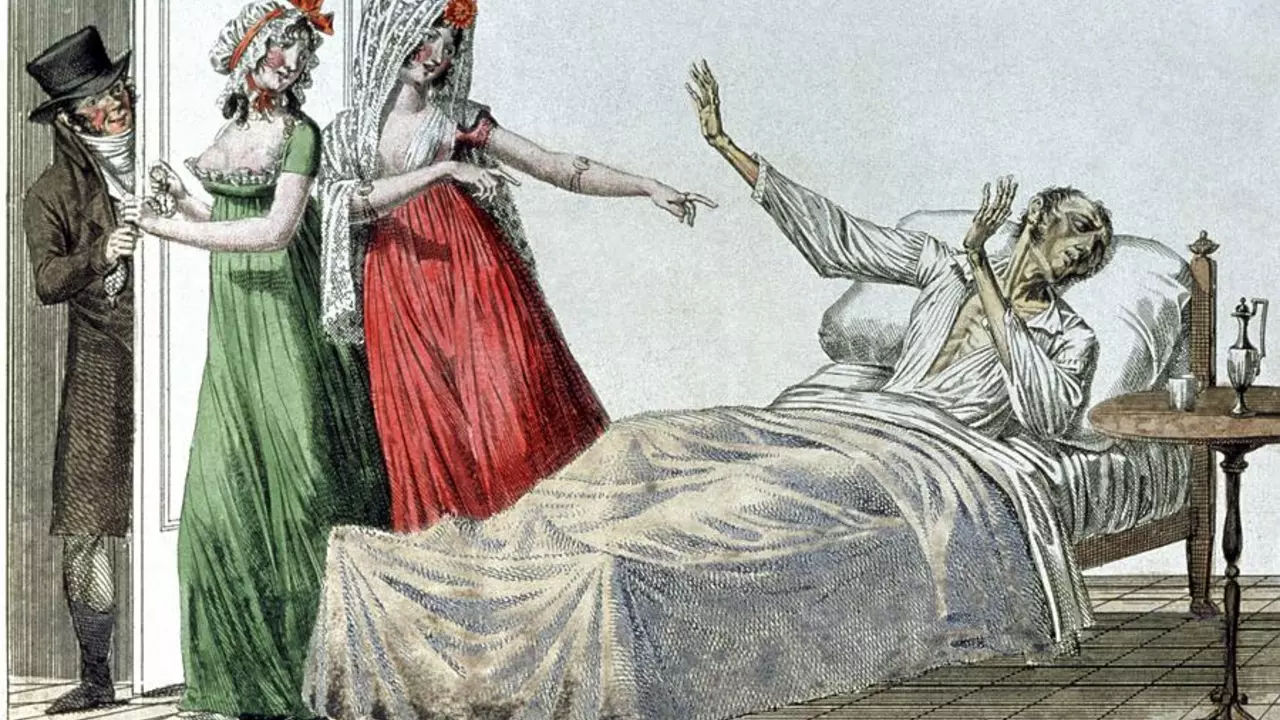The Concealed Connection: Syphilis and The Arts
Often, when we think about forces that shape creativity, diseases aren't usually in the running. Yet history presents a startling and captivating, almost Kafkaesque, narrative of how syphilis, a bacterial infection transmitted through sexual contact, has, disquietingly enough, influenced the arts in sweeping proportions. It's generally not the first thing that pops into mind when watching a classical concert, reading a literary masterpiece, or admiring a seminal painting, but that subtly adds to its intrigue.
Imagine rubbing shoulders with the who's who at an art exhibit, wine glass in hand, and casually pointing out, "Well, this piece here? Clearly influenced by syphilis," followed by the resultant eyebrow raises and polite coughs. It's not small talk, it's big, bold, and startlingly real.
A Disease As Old As Time
Before diving into the artistic impact of syphilis, let's get our facts straight about the bacterium itself. Treponema pallidum has stubbornly survived through the ages, making its unwanted presence felt in bones and body tissues, corroborated by ancient skeletal surveys. Jean Markale's "The Celts" posits the anecdotal possibility of a Celtic chieftain spreading syphilis across Europe in his enthusiastic displays of virility, and Albrecht Dürer, the German Renaissance master, addressed syphilis in his works as early as 1496.
Getting grimly poetic here, I could say syphilis is quite the artist itself, painting inflammatory lesions inside the bodies of its unwitting hosts, and silently altering neurological and cardiovascular processes. Downright surreal, very Salvador Dali, isn't it?
Masters Under the Shadow: Famous Artists Afflicted
The narrative takes a twisted turn as we approach artists influenced by the disease, some even directly affected. A fascinating spectrum of giants in their field got entangled with Treponema pallidum at some point in their lives. Paul Gauguin, Henri de Toulouse-Lautrec, Édouard Manet, Ludwig van Beethoven - the list is notable, intriguing, and unnervingly extensive.
Syphilis defyingly crushes the conservative stereotypes of the disease, transcending social classes and disciplines, colorfully speckling its presence across impressionist artist's canvases, inside the innovative minds of composers, and lurking between the words of philosophical discourses. It's a peculiar but empirically grounded claim which we can't ignore.
Literary Inkings of Syphilis
The literary world hasn't been immune to syphilis, both on the page and off it. The trail of this disease crawls into the lives and works of famed authors. Guy de Maupassant's madness, bared open consanguineously in his late works, and the suggestively decrepit, decadent worlds spun by Charles Baudelaire in his ‘Flowers of Evil’, hint towards the lurking presence of the disease.
John Keats, the romantic era giant, made references to the feared ‘French Disease’ in his works. Interestingly, a more personal brush with the disease also comes from the literary giant and acclaimed contrarian, Friedrich Nietzsche, whose alleged autobiographical accounts of his struggle with syphilis are well documented.
The Symphonic Strains of Syphilis
Jarring as it may sound, the connection between syphilis and symphonic compositions might just be more than coincidental. The genius minds of Franz Schubert and Ludwig van Beethoven, two of the greatest composers, battled the symptomatic trials of the disease, reflecting in the melancholic strains and discordant notes of their works.
The ghastly specter of syphilis lingering behind some of the most soul-stirring compositions of all time is unsettling, to say the least. But it urges us to examine the distressing borderline that separates personal pain from artistic prowess. It's the sort of association that puts you in a pensive, brooding state of mind, much like listening to a Schubert string quartet on a rainy day.
A Riot of Colors on Canvas
Moving onto visual arts, syphilis starts making more insinuations. Gauguin's undeniably influenced pieces resonate with the psychological struggles unique to the disease-affected. Édouard Manet, on his deathbed suffering from advanced symptoms, produced a collection of incredibly haunting portraits.
Did you know that even the genre of macabre art found fuel in the symptoms and fears surrounding syphilis? The bizarrely grotesque style embodied in the paintings of Austrian painter Egon Schiele is just one fascinating instance. I mean, who would have thought that a tiny spirochete could wield such a whopper of influence on entire artistic movements, right?
Winding Down: The Modern Narrative
We aren't left untouched by the influence of syphilis in contemporary narratives. The subversive and provocative works of David Wojnarowicz, the dialogues started by Derek Jarman's 'Blue', and the churning narrative in Pedro Almodóvar's 'Law of Desire' - they all echoed the struggle and stigma associated with syphilis.
There is no denial of the detrimental health impact of syphilis, but one also shouldn't neglect its society-shaping power either. It's a loathsome reality, but indisputably, an important part of our cultural chronicle. As we collectively strive to shed disease-centric stigmas, maybe it's time to appreciate the paradoxical aspect of notorious pathogens fueling expressions of human ingenuity as well.
Retrospective: Learning From History
Learning about syphilis as an element of artistic influence isn't just an eccentricity; it provides critical socio-anthropological insights. Translating public health history into contemporary practices opens up conversations we need to have. Understanding historic syphilis' influence on society indubitably provides a contextual understand of the power diseases hold.
There's an undeniable parallel between past syphilis impacts and present-day challenges with mental health issues, HIV/AIDS, and COVID-19. Perhaps we should approach such diseases not merely with a medical lens but a socio-cultural one too - now there's a thought that’ll inflate those cultured eyebrows at family dinners!
All said and done, I can't help but imagine a congregation of affected artists: Manet painting in the corner, Keats penning down an ode while Nietzsche, ever the contrarian, is passionately arguing against the very premise of this article. So here's to syphilis, that unasked-for muse that lingered at the edges of the creative minds throughout history - let's hope its influence will, eventually, be confined only to history books.








Comments
Rashi Shetty
July 31, 2023It is both astonishing and disquieting that a pathogen such as syphilis has carved a niche within the annals of artistic achievement, and yet one must exercise discernment when attributing creative brilliance to disease alone. The historical record indicates that many of the aforementioned figures suffered under circumstances that extended far beyond a mere infection. One cannot overlook the sociocultural pressures that shaped their output, which were arguably more decisive than any microbial influence. Consequently, while the narrative is compelling, it should be approached with scholarly rigor and a dash of caution 😊.
Queen Flipcharts
August 6, 2023The intertwining of pathology and artistic expression is a subject that resonates deeply within the American cultural psyche, where triumph over adversity is glorified. Yet to proclaim syphilis as a muse is to romanticize suffering in a manner unbefitting the republic’s values. A nation's artistic legacy should be celebrated for its innovation, not for an opportunistic exploitation of disease narratives. Indeed, the United States has produced masterpieces independent of such morbid inspirations.
Yojana Geete
August 11, 2023Whoa you think disease isnt part of the canvas its like a hidden brushstroke that we never see but it stains the whole picture the drama is real and the suffering adds depth to the art
Jason Peart
August 17, 2023Hey folks, I totally get the intrigue. It's wild how syphilis could've nudged some creators in unexpected ways. I mean, look at those late works-there's a raw, almost vulnerable vibe you can't ignore. Sure, we shouldn't blame the disease for genius, but recognizing its shadow can give us a richer perspective. Sorry for the typos, my excitement got the best of me!
Hanna Sundqvist
August 22, 2023They’re just covering up the real agenda behind the art world’s obsession with disease.
Jim Butler
August 28, 2023Let us celebrate the resilience of artists who turned personal hardship into timeless masterpieces! Your dedication to exploring this nuanced topic is commendable, and it inspires us all to look beyond the obvious. Keep shining a light on these hidden histories, and let the world see the full spectrum of human creativity. 🌟✨
Ian McKay
September 2, 2023While the enthusiasm is appreciated, there are several grammatical inaccuracies in the previous comment that merit correction. For instance, “your dedication” should be capitalized only at the beginning of a sentence, and “the world see” lacks a verb. Precision in language strengthens the overall argument.
Deborah Messick
September 8, 2023It is rather presumptuous to posit that a disease could serve as a catalyst for artistic genius. One must consider that correlation does not imply causation, and the romanticization of pathology is intellectually lazy. The true drivers of creative output lie within socio-economic contexts and personal philosophies, not within the confines of a bacterial infection.
Jolanda Julyan
September 13, 2023Honestly, the whole idea that a nasty spirochete could be behind some of the greatest works of art is both fascinating and absurd. The art world loves a good scandal, and this narrative fits perfectly into that appetite for drama. You can see how the stories of Gauguin, Manet, and even Schubert are twisted to fit this lucky hypothesis. First, we must accept that many of these artists lived in times where medical knowledge was limited, so their ailments were often misunderstood. Second, the symptoms of syphilis, such as melancholy and intense emotional swings, could easily be mistaken for artistic temperament. Third, the stigma attached to the disease forced many creators into isolation, which, in turn, gave them more time to reflect and create. Fourth, the very act of battling a serious illness could sharpen a person's perception of suffering, making their art more profound. Fifth, patrons of the arts sometimes romanticized the “tortured artist” trope, further cementing the link in popular imagination. Sixth, even the language used by critics of the era often invoked disease as a metaphor for artistic decay or brilliance. Seventh, many of the paintings and compositions from that period contain dark, somber tones that align with the gloom associated with syphilis. Eighth, the notion that a pathogen could act as a muse is a compelling narrative that sells books and exhibitions. Ninth, you have to wonder how many of these connections are truly evidence-based versus retroactive speculation. Tenth, the scientific community has yet to produce conclusive data linking syphilis directly to heightened creativity. Eleventh, the psychological impact of chronic illness can certainly affect an individual's output, but it does not automatically make it superior. Twelfth, the stories we hear today are filtered through centuries of myth-making and sensationalism. Thirteenth, while some artists may have indeed suffered from the disease, their brilliance likely stemmed from a complex mix of talent, training, and personal experience. Fourteenth, the romantic allure of the “diseased genius” persists because it satisfies our desire for dramatic backstories. Fifteenth, in the end, the art stands on its own merits, irrespective of any alleged medical influences. Finally, we should appreciate these works for their intrinsic value rather than attributing them to a microscopic culprit.
Kevin Huston
September 19, 2023The intertwining of disease and creativity is a classic case of sensationalist history, but let’s cut through the melodrama. While it’s tempting to blame the “French Disease” for a surge in melancholic symphonies, we must remember that the cultural milieu of the 19th century was already steeped in Romantic despair. Moreover, attributing a composer’s brilliance to a pathology is an oversimplification that does a disservice to their craft. Still, the anecdotal evidence does add a tantalizing layer to our understanding of artistic motivation. In short, the narrative is intriguing, but it should be weighed against broader historical forces.
Amanda Hamlet
September 24, 2023Honestly, you’re missing the bigger picture. The so‑called “tantalizing layer” is just a convenient excuse to ignore the real political and economic pressures these artists faced. Also, the claim that syphilis added depth is pure speculation-no peer‑reviewed study backs it up. And let’s not forget the misogynistic undertones when we glorify male suffering while sidelining female artists who dealt with the same disease.
Nolan Jones
September 30, 2023Interesting take on the whole disease‑art connection. I think it’s worth noting that many of the cited works were also influenced by contemporary philosophical movements, which might explain the darker tones. Also, the medical records from that era are spotty, so any direct link is hard to prove.
Jada Singleton
October 5, 2023The argument presented suffers from a glaring bias, treating syphilis as an artistic catalyst while neglecting its devastating human toll. One must balance the romanticized narrative with the harsh reality of suffering endured by countless individuals. Moreover, the selective focus on a handful of famous figures creates a distorted picture of the broader artistic landscape.
Emily Rossiter
October 11, 2023Thanks for sharing this nuanced perspective. It’s helpful to remember that while disease can influence an artist’s experience, their work ultimately stands on its own merit. Let’s continue to discuss these topics with respect and an open mind.
Renee van Baar
October 16, 2023While the historical anecdotes are compelling, we should also consider the methodological limitations of attributing creative output to a single factor. In practice, artistic inspiration is a complex interplay of personal, cultural, and environmental influences.
Mithun Paul
October 22, 2023From a rigorous analytical standpoint, the correlation between syphilis and artistic production remains tenuous at best. The available evidence is often anecdotal, and the causative mechanisms are not substantiated by contemporary medical research.
Sandy Martin
October 27, 2023I appreciate the depth of this discussion and empathize with those who have suffered from such illnesses. It’s crucial that we continue to explore the intersections of health and culture with compassion and scholarly diligence.
Write a comment